A Player-Facing Sandbox Part 1 - The Map
I had intended for a while to write a fairly dry, mechnical post about the gameplay implications of travel distance and hence on map building, but then a couple of things happened:
- I read Prismatic Wasteland’s excellent hexcrawl checklist (Part 1 and Part 2)
- I watched Map Crow’s video, which packs a lot of good map design (including some valuable points from open world videogames) into just 15 minutes.
And I thought “well, there’s probably enough theory out there… but perhaps I can create an example of how I build something”.
But this post is also meant to show how I iterate between mechanics and fiction. In my opinion each drives the other, and it’s by considering both that we achieve ludonarrative harmony, rather than dissonance.
Some Assumptions
We aren’t going to be building for a particular system here, but we should at least set our baseline mechanics and fiction. Let’s assume we’ve had our Session 0 or equivalent, and agreed that:
- We want to play a hexcrawl - players are expecting isolated settlements, overland travel and emergent gameplay.
- The players are going to be given a map of the area, along with some rumours and other general information.
- We’re using Gold-as-XP AND/OR that accumulating treasure is the default motivation of our PCs. Much of the advice below works without this, but remember this is baseline.
- We have some sort of mechanics (e.g. travel per terrain type, random encounter rolls etc) that help the GM adjudicate these expeditions into the wilderness. My own system is a bit like OSR Simulacrum’s one here.
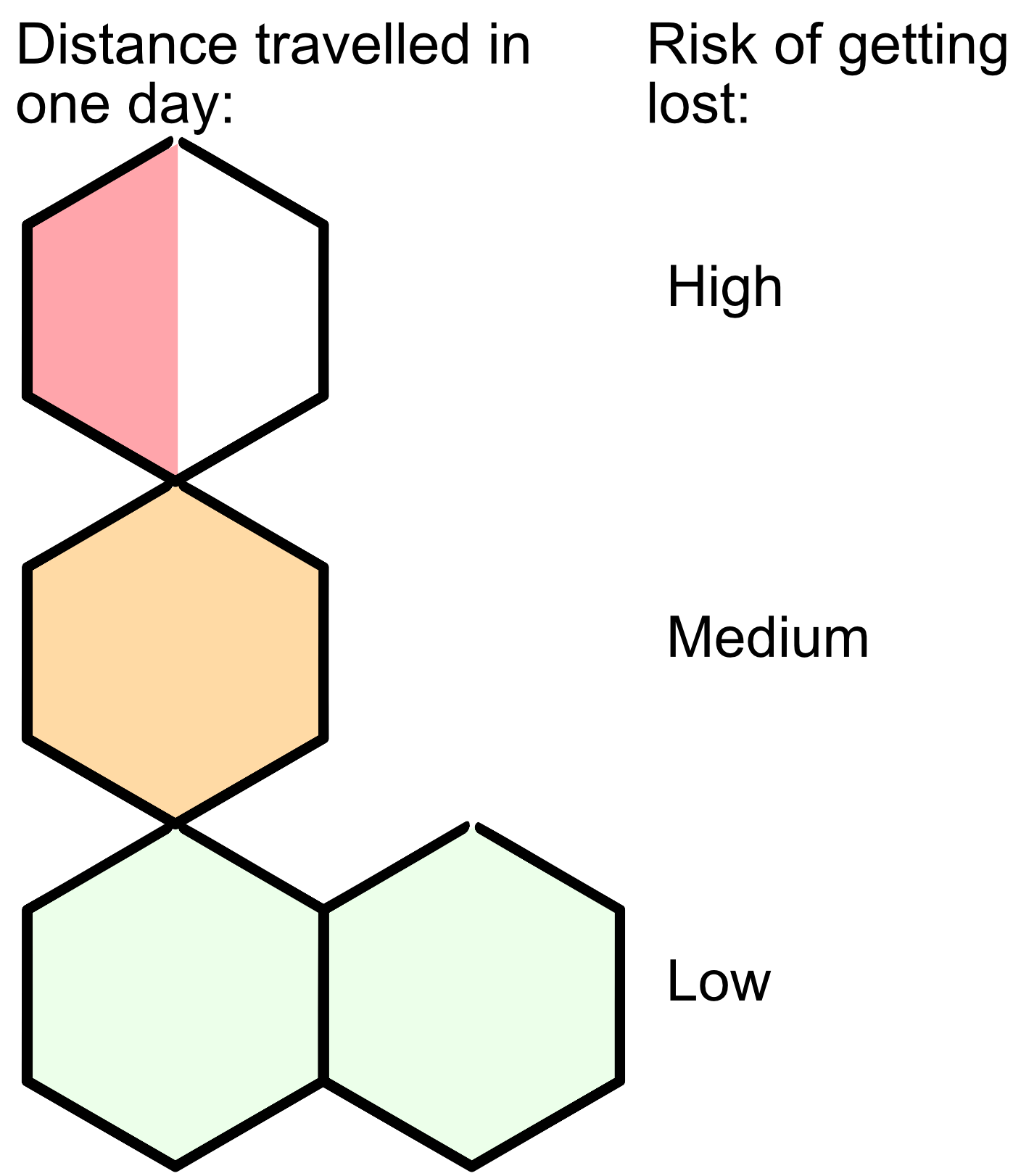 A typical terrain classification and mechanical impact.
A typical terrain classification and mechanical impact.
In keeping with this idea of a common baseline, the theme of the example below does not see us stepping outside a typical lowish-magic, vanilla, vaguely European fantasy realm.
1. A Starting Point and Obvious Hook
The starting point is straightfoward - we need a settlement. This is an incredibly broad concept, because mechanically it just needs to serve the following purposes:
- Be a source of information
- Somewhere to sell treasure and restock on basic supplies (such as new party members)
For a longer campaign, you probably also want it to be part of the stakes for the characters - somewhere they can develop, that can be threatened, contains people they rely on etc… but we don’t need to prep that especially, as it will emerge through play. Basically, don’t make it an impregnable utopia - not least because the characters need to want to leave…
You will note that I specified an obvious hook. What makes a hook obvious?
- The hook is presented clearly to the PCs. There can still be twists and mystery, but the information shouldn’t be vague. Go to this place. Perform this specific task. Obtain this exact object.
- Broadly within the PCs capabilities. Or at least the first step towards it is.
- Have a reward that the PCs desire. Bigger rewards are more obvious but so are rewards with fewer complications.
Thus: “Your beloved sister Isabel tells you that there is a drawer in the room next door that contains a diamond worth 1000GP” Is an obvious hook. “Your nemesis David the Liar says that over the hills and far away a gigantic dragon guards a magical piano that probably means you won’t ever catch a cold again” Is not.
But of course, the first example there contains no obstacle, no threat and no narrative payoff or sense of accomplishment. So before we detail what our hook is in the fiction, we should think mechanically about where we want to place it.
2. Populating the Map
At this point, I must reference Anne’s post over at DIY and Dragons. As Prismatic (“Please, Mr. Wasteland is my father”) notes in their list, it’s the gold standard for this sort of thing. The only thing extra I do in my interpretation is to tag certain hex contents as threats (on which more below).
A player-facing map is inherently landmark information - player characters can refer to it at any time and it does not cost them anything to do so. This means that any points of interest placed on the map (either in the initial handout or added later via player action) are also landmark information. Classic examples are:
- Terrain type and climate
- Routes such as rivers or public roads (trails and shortcuts may well be hidden. The Mines of Moria are risky)
- Names of settlements, forests, mountain ranges etc (on which more in Part 2)
- Visual landmarks (something visible from a distance: a volcano, a prominent statue, a huge tree)
- Commonly known information (a shrine behind a waterfall can still be famous if hundreds of pilgrims visit each year, a stretch of marsh with a particular hazard will produce warnings about the area)
- Political or cultural borders (although the precise demarcation is usually blurry on the ground, this can make for interesting gameplay when it comes to changes in laws/authority between different areas)
The first two points above are what interest us initially, as they allow players to determine the approximate time and risk for a particular route. We want our players to make interesting and informed choices, and we also want them to fully engage with the wilderness mechanics of the game. Therefore, the obvious hook should:
- Have a selection of viable routes leading to it.
- Require spending at least one night in the wilderness to explore and return.
- Expose the players to other distractions and/or dangers along the way.
With the terrain mechanics assumed above, we generate this: 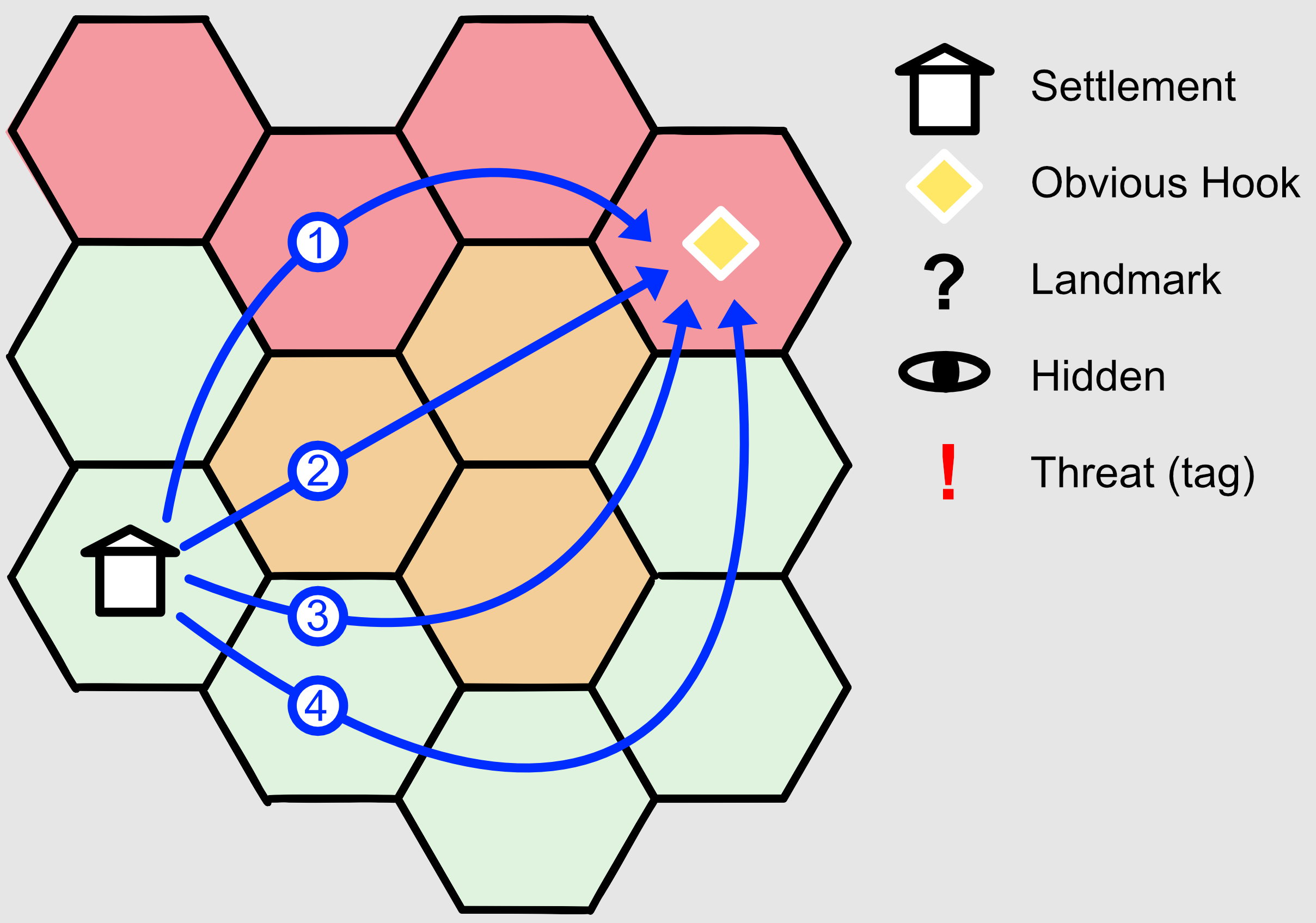 We have four possible ways of reaching our obvious hook from the settlement. Routes 2, 3 and 4 will all take around the same travel time but each carries slightly less risk. Route 1 is much slower. We need to balance these out a little, so we add:
We have four possible ways of reaching our obvious hook from the settlement. Routes 2, 3 and 4 will all take around the same travel time but each carries slightly less risk. Route 1 is much slower. We need to balance these out a little, so we add:
- An additional obvious hook to route 1, to make it more appealing
- Landmarks to routes 2 and 3
- Extra risk to route 4
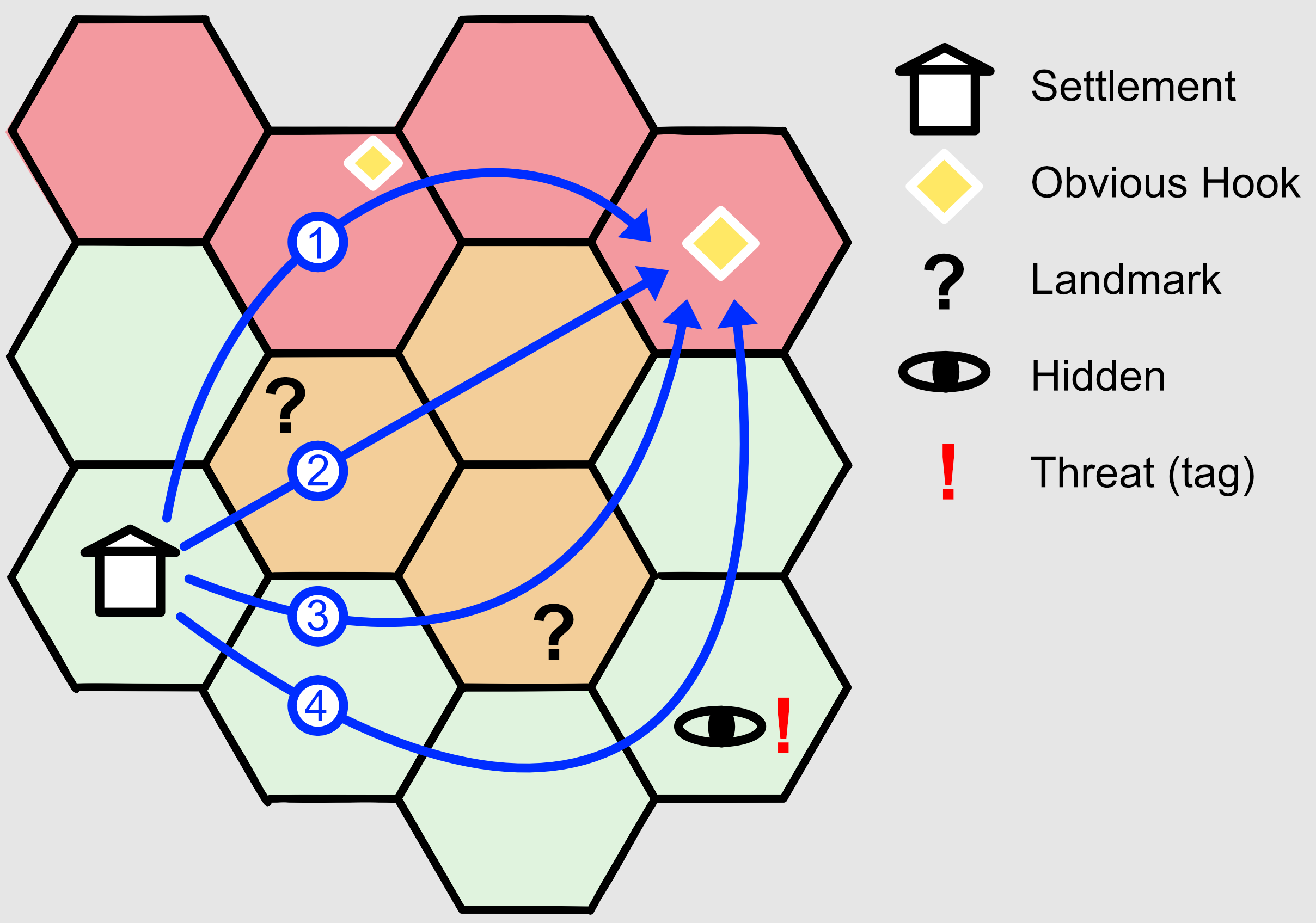 This is better, and plus the map is starting to look more populated! But there’s still a little to be done in and around the obvious hook itself.
This is better, and plus the map is starting to look more populated! But there’s still a little to be done in and around the obvious hook itself. - Tagging the hook as a threat makes it more interesting and helps define the fiction in the next step
- Adding some nearby hidden features means more of a sense of discovery as the PCs venture further from the settlement
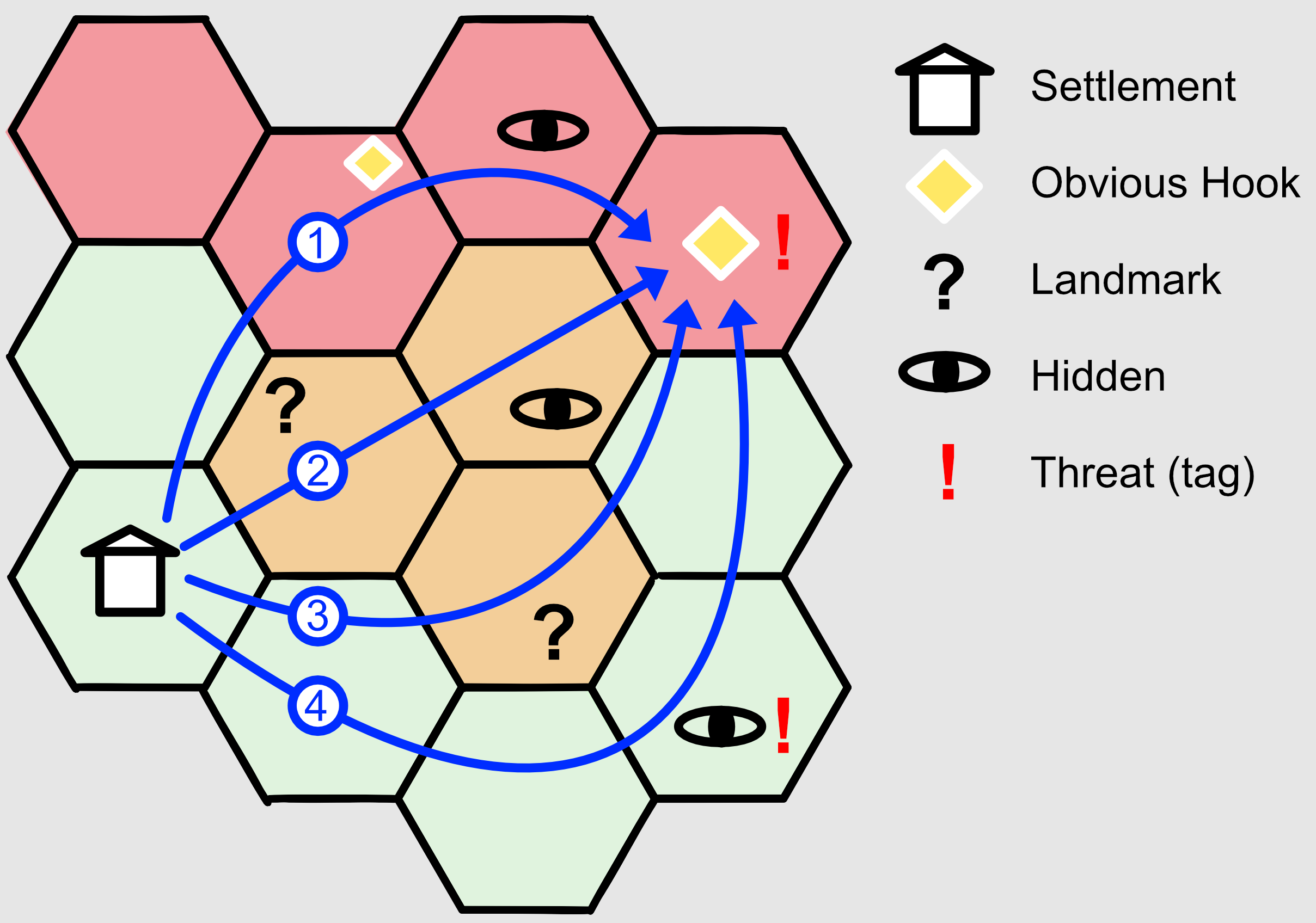 Now we have our mechanical framework, we can generate some fiction to hang on it.
Now we have our mechanical framework, we can generate some fiction to hang on it.
3. Defining the Points of Interest
In my opinion, a hex’s point of interest should provide at least one of the following, and preferably more:
- Loot and treasure to obtain (or some other reward e.g. a boon from a minor diety)
- An interesting choice or dilemma
- Something that is time-dependent
- A notable foe to defeat
- Lore and history about the world
- An obscure secret (see secrets in Landmark, Hidden, Secret)
- Information about another point of interest, rumour or hook
- A puzzle to solve
- An NPC to talk to or otherwise peacefully interact with (e.g. a merchant)
- A reason to return
- An entrance to a dungeon
(Readers will notice some intentional similarities here with Arnold K’s dungeon checklist)
The other important reason for variety within the points of the interest is it allows the GM to gauge what the players are interested in. By offering a menu, you can see their preferences and understand not merely the sort of thing to add as the campaign builds, but also where you should go light and heavy on your prep. For example, if your players are heavily invested in the history, then you can build a timeline of different eras/interactions to discover.
Note that we’re assuming for simplicity’s sake that each hex has one point of interest - I will sometimes have zero (especially close to a settlement, as seen in this example) and sometimes have two (so that players don’t assume they’ve found everything). For an actual campaign I would do this process a few times in various directions from the settlement (and add at least one additional settlement as well).
On Threats
I’ll talk about this more in Part 2, but with respect to tagging certain points of interest as ‘threats’. What this means in general terms is “Something that has the potential to grow in danger, either to the party and/or something they care about”. A threat might get fleshed out into a front, complete with goals and a faction clock… but it might not need to be. My most memorable threat from a previous campaign was simply an unnaturally fast-growing plant that was cutting off a settlement’s water supply the more it grew.
Illustrating the Map
I’m going to go with a very standard combo of grassland, hills and mountains to make it clear how I’ve matched it to the terrrain difficulties above. 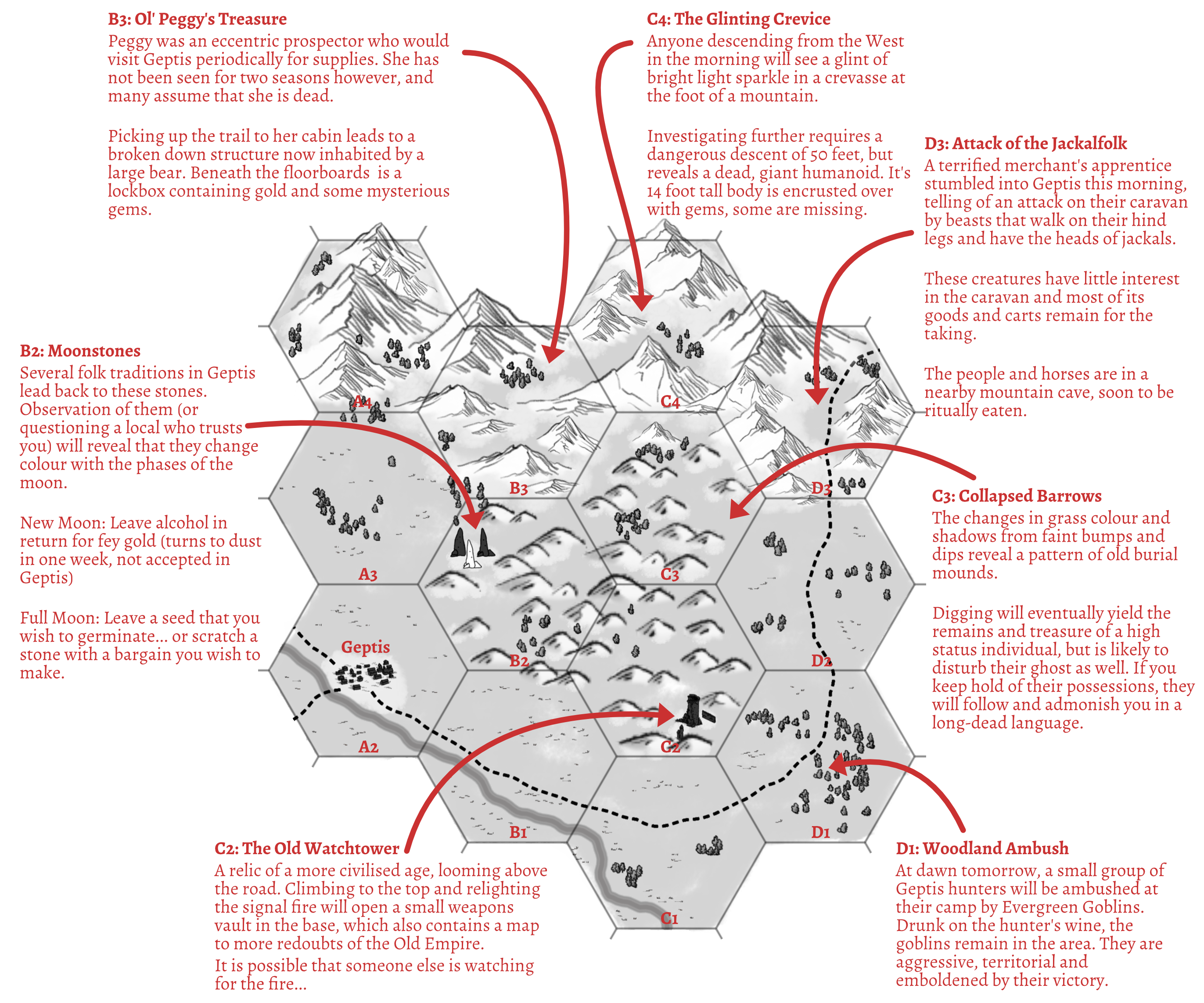 People ask me fairly often how I make these (especially those who are familiar with my C grades in both GCSE Art and Graphic Design). It’s actually fairly simple - I use Wonderdraft with the default assets, taking care to use a limited colour palette (greyscale for an example like this, but I used soft natural colours for this piece). I find taking note of the relative size of mountains/hills/trees/settlements is important. It doesn’t have to be to scale, but should imply that one is bigger than the other.
People ask me fairly often how I make these (especially those who are familiar with my C grades in both GCSE Art and Graphic Design). It’s actually fairly simple - I use Wonderdraft with the default assets, taking care to use a limited colour palette (greyscale for an example like this, but I used soft natural colours for this piece). I find taking note of the relative size of mountains/hills/trees/settlements is important. It doesn’t have to be to scale, but should imply that one is bigger than the other.
Names and hex codes (along with arrows and notes in this example) are then layered over the top using Affinity Designer. You can do the hex grid in Affinity as well if you want (set your grid to triangular) or indeed write labels in Wonderdraft (but Affinity has more power to layer, baseline etc plus a lot more fonts).
Design Notes
D3 is our obvious hook - the PCs can be clearly told that, whilst the captives/dead bodies might have treasure on them, the bulk of the goods and valuables are not of interest to the foes here. It’s all just sitting around for the taking! And since it’s created by the same civilization as the PCs it is easy to appraise its cash value! There are, of course, some further reasons:
Presenting at least some members of the caravan as captured rather than slaughtered creates a moral dilemma, a potential dungeon nearby and the prospect of an additional reward/favour.
There is a classic OSR encumbrance puzzle (How do we get these trade goods back when all the horses are dead? If we bring horses along, will we get attacked ourselves?).
The scared merchant’s apprentice is fun to roleplay with.
The threat here is obvious: If the party don’t defeat the jackalfolk, they will grow bolder and stronger. Making it more of a magical ritual distinguishes it from the goblins in D1.
Jackalfolk (this world’s take on Gnolls) allow for some truly alien motivations (like the classic demon worship) but also lets the players make deductions/assumptions based on real world animal behaviour.
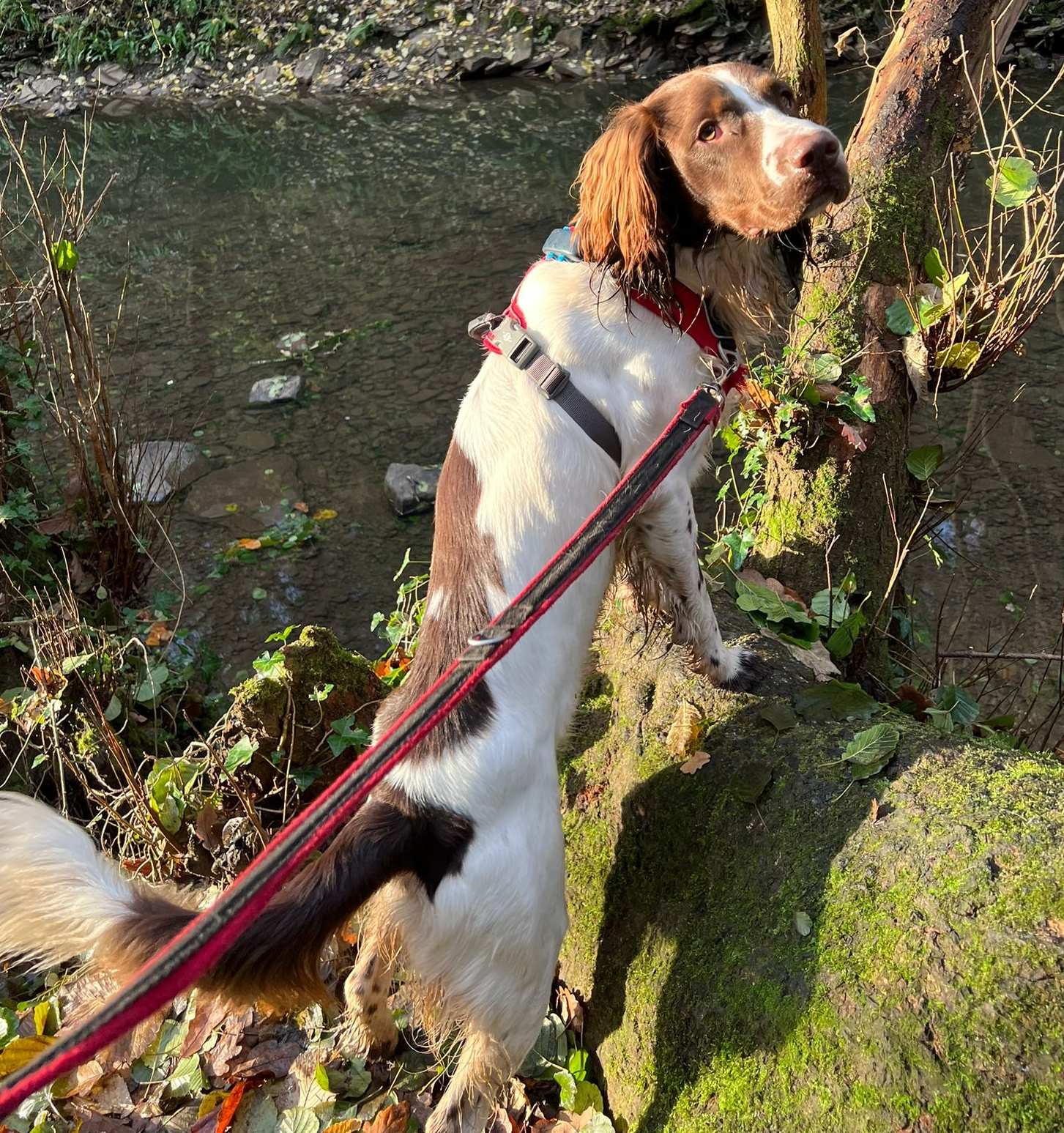 Terrifying bipedal canines
Terrifying bipedal caninesB3 leaves Peggy’s fate ambiguous, so she might not be too happy if she finds out she’s been robbed. It’s also deliberately not too challenging - a party should have lots of options to get past the bear rather than engaging it directly. It’s intended to be an obvious hook, but not as obvious as the caravan above. A more mystery-focused party has plenty of intrigue here along with C4 and B2.
C4 is an attempt to add mystery and treasure but is hazardous and hard to find. A reward for those scouring the mountains or intrigued by the contents of B3.
B2 is deliberately variable with time. It rewards further investigation and repeated visits. Potentially the start of a big scheme by the PCs, especially if they can rope in some allies from Geptis. Equally not worth fleshing out in much more detail yet because they might just write it off as too risky from the start!
C3 was originally going to be something to fight, but I decided that a curse was more entertaining and had more interesting consequences. You could add something here about a creature (either sentient or not) investigating the holes dug by the party.
C2 is the classic ‘that thing on the horizon looks interesting’. Could be the start of a whole plot line or just be used to underline how old and mysterious this land is. Implies a breakdown of law and order relative to the past, which is a thematic link to our obvious hook.
D1 features everyone’s favourite: drunken goblins. Lots of options for information to leak out in advance of them being encountered, since they’re not exactly stealthy. A threat nonetheless, and if I was to expand the map further they would be a whole civilization in a forest further South. Deliberately left ambiguous as to whether they want to rob, ransom, enslave or eat the hunters.
4. What comes next
You will note that we don’t yet have the following:
Names on the map other than the starting settlement
A rumour table
A random encounter table
Weather
Factions or faction clocks
Any drawings of creatures on the map
These will be covered in part 2. That’s mostly because I see them as filling in the gaps between the defined points of interest already established - partly because I don’t want them to contradict anything we’ve already prepped, but mostly because I consider them a key part of the information flow from GM to players.
Until next time!